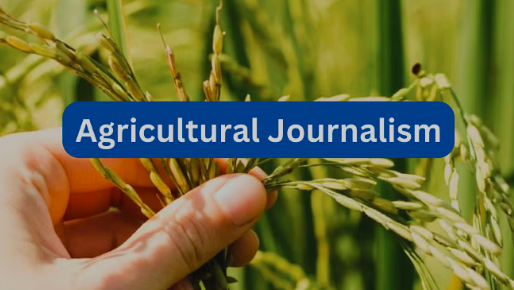
In the vast fields of agriculture, where crops sway in the breeze and livestock graze beneath open skies, there exists a critical bridge between the farming community and the wider world. Agricultural journalists play a pivotal role in nurturing this connection, transforming the complexities of agriculture into stories that inform, educate, and resonate with audiences. In this exploration, we will plow through the rich soil of agricultural journalism jobs, delving into their unique characteristics, responsibilities, challenges, and the ever-evolving landscape of this vital profession.
Historical Roots
The roots of agricultural journalism can be traced back to the agricultural revolution when early publications disseminated information on farming techniques, crop varieties, and livestock management. As societies transitioned from agrarian economies to industrialized nations, the need for specialized agricultural reporting became evident. Agricultural journalists emerged to bridge the gap between the farming community and urban populations, offering insights into the challenges, innovations, and successes of agriculture.
Print publications, such as agricultural newspapers and magazines, became instrumental in sharing knowledge among farmers and fostering a sense of community. As technology advanced, agricultural journalism expanded to radio, television, and, more recently, digital platforms. Today, agricultural journalists continue to serve as storytellers, educators, and advocates for the agricultural sector.
The Role of Agricultural Journalists
Communicating Agricultural Stories
At the heart of agricultural journalism lies the responsibility to communicate the stories of agriculture. Agricultural journalists use their communication skills to translate technical information, scientific advancements, and the day-to-day realities of farming into accessible narratives. These stories may cover a broad range of topics, including crop management, livestock practices, agribusiness trends, rural development, and the intersection of agriculture with environmental and policy issues.
The goal is not just to convey information but to humanize the agricultural experience, making it relatable to diverse audiences. This may involve profiling individual farmers, exploring unique farming practices, or investigating the impact of agricultural policies on local communities.
Bridging the Gap Between Farmers and Consumers
Agricultural journalists serve as a vital link between the agricultural community and consumers who may be geographically and culturally distant from farming realities. By presenting accurate and engaging stories, journalists help consumers understand the complexities of food production, the challenges faced by farmers, and the innovations driving agricultural sustainability.
This bridging role is crucial in an era where consumers are increasingly interested in the origins of their food, sustainable farming practices, and the impact of agriculture on the environment. Agricultural journalists act as interpreters, breaking down complex topics into digestible information that fosters a more informed and connected society.
Educating and Informing
Agricultural journalists are educators at heart, providing valuable information to diverse audiences. Farmers rely on agricultural journalism to stay abreast of the latest research, technologies, and market trends that can impact their operations. Extension agents, educators, and policymakers also turn to agricultural journalism for insights that inform their decisions and initiatives.
Education through agricultural journalism extends beyond traditional media outlets. The digital era has opened new avenues, including blogs, podcasts, webinars, and social media platforms, allowing journalists to reach a global audience and engage with communities in real-time.
Advocacy and Awareness
Advocacy is woven into the fabric of agricultural journalism. Journalists often champion the causes and challenges faced by the agricultural community, advocating for policies that support sustainable farming practices, fair trade, and rural development. By raising awareness about issues such as climate change, water management, and food security, agricultural journalists contribute to public discourse and influence decision-makers.
Advocacy in agricultural journalism requires a delicate balance between objectivity and a commitment to fostering positive change. Journalists must navigate the complexities of diverse perspectives within the agricultural sector while remaining true to the principles of ethical reporting.
Challenges in Agricultural Journalism
Complexity of Agricultural Topics
Agricultural journalism is not without its challenges, and one of the foremost is the inherent complexity of agricultural topics. Agriculture encompasses a wide range of disciplines, from agronomy and veterinary science to economics and environmental science. Journalists must distill this complexity into accessible narratives without oversimplifying or sacrificing accuracy.
The intricate nature of agricultural topics demands a commitment to continuous learning. Agricultural journalists often find themselves delving into specialized areas, attending conferences, and collaborating with experts to stay informed about the latest developments in the field.
Bridging the Rural-Urban Divide
As the majority of the global population becomes increasingly urbanized, there exists a growing divide between urban consumers and rural producers. Agricultural journalists face the challenge of bridging this gap, ensuring that stories from rural communities resonate with urban audiences. Effective storytelling becomes a tool for breaking stereotypes, fostering understanding, and building a connection between those who produce food and those who consume it.
Changing Media Landscape
The digital revolution has transformed the media landscape, presenting both opportunities and challenges for agricultural journalists. Traditional print publications face the pressures of declining readership, while online platforms offer new possibilities for reaching diverse audiences. Navigating this evolving landscape requires agility and a willingness to embrace digital tools, social media, and multimedia storytelling formats.
However, the rapid dissemination of information on digital platforms also poses challenges related to accuracy and misinformation. Agricultural journalists must navigate this terrain responsibly, ensuring that their reporting maintains high standards of accuracy and credibility.
Economic Pressures on News Outlets
Economic pressures on news outlets, including declining advertising revenues and changing reader habits, impact the resources available for agricultural journalism. This can result in reduced coverage of agricultural issues, limited investigative reporting, and a focus on sensational rather than substantive stories.
Journalists and media organizations must navigate these economic challenges while prioritizing the importance of agricultural reporting. Collaborations between agricultural organizations, philanthropic initiatives, and innovative business models are emerging as potential solutions to sustain high-quality agricultural journalism.
The Evolving Landscape of Agricultural Journalism
Digital Innovation and Multimedia Storytelling
The digital age has ushered in a new era of innovation and possibilities for agricultural journalism. Digital platforms offer journalists the ability to reach global audiences, engage with communities, and experiment with multimedia storytelling formats. Blogs, podcasts, video content, and social media platforms provide diverse channels for conveying agricultural stories in dynamic and visually compelling ways.
Multimedia storytelling allows journalists to capture the sights and sounds of farming, bringing the audience closer to the realities of agriculture. This immersive approach enhances the storytelling experience and facilitates a deeper connection between the audience and the agricultural narrative.
Citizen Journalism and Community Engagement
The rise of citizen journalism and community engagement initiatives has expanded the scope of agricultural reporting. Farmers, agri-entrepreneurs, and rural residents are increasingly becoming storytellers, sharing their experiences, challenges, and innovations through blogs, social media, and community platforms.
This democratization of storytelling enhances the diversity of voices in agricultural journalism, providing a more comprehensive and nuanced understanding of the sector. Agricultural journalists, in turn, can collaborate with citizen journalists, fostering a sense of community and shared responsibility for agricultural communication.
Data Journalism and Precision Agriculture
The integration of data journalism techniques has transformed the way agricultural stories are told. Data-driven reporting allows journalists to analyze and present information in compelling visual formats, providing insights into trends, patterns, and the impact of agricultural practices.
Precision agriculture, which involves the use of data and technology to optimize farming operations, has become a focal point in agricultural journalism. Journalists explore how technologies like GPS, drones, and sensors are revolutionizing agriculture, improving efficiency, and addressing environmental challenges.
Environmental and Sustainability Reporting
Environmental and sustainability issues have taken center stage in agricultural journalism. Journalists are increasingly covering topics such as climate change impacts on agriculture, sustainable farming practices, and the role of regenerative agriculture in mitigating environmental challenges.
Agricultural journalists contribute to public awareness and discussions on the importance of sustainable and environmentally friendly farming methods. This focus aligns with global concerns about food security, biodiversity loss, and the need for resilient agricultural systems.
Education and Skills for Agricultural Journalists
Becoming an agricultural journalist requires a unique blend of education, skills, and a passion for both storytelling and agriculture. While formal education in journalism or communications is beneficial, a solid understanding of agricultural concepts and practices is equally important. Key skills for agricultural journalists include:
- Agricultural Knowledge: A strong foundation in agricultural science and practices is essential for accurate and insightful reporting.
- Journalistic Skills: Proficiency in journalistic principles, including research, fact-checking, interviewing, and news writing.
- Multimedia Skills: The ability to leverage multimedia tools, including photography, videography, and podcasting, enhances the storytelling experience.
- Digital Literacy: Familiarity with digital platforms, social media, and data journalism tools is crucial in the current media landscape.
- Communication Skills: Effective communication, both written and verbal, is fundamental for conveying complex agricultural topics to diverse audiences.
- Networking: Building relationships with farmers, agricultural experts, policymakers, and industry stakeholders enhances access to information and diverse perspectives.
- Adaptability: Given the dynamic nature of agriculture and media, agricultural journalists must be adaptable to changing technologies, emerging trends, and evolving audience preferences.
Conclusion
In the ever-expanding fields of agriculture, where each season brings new challenges and opportunities, agricultural journalists stand as cultivators of knowledge. Their role goes beyond reporting; it involves sowing seeds of understanding, nurturing connections between rural and urban communities, and harvesting stories that illuminate the intricate tapestry of agriculture.
The historical roots of agricultural journalism, dating back to the agricultural revolution, have blossomed into a vibrant profession that continues to evolve. From the early days of print publications to the digital age of multimedia storytelling, agricultural journalists have adapted to the changing landscapes of both agriculture and media.
Challenges in agricultural journalism, whether navigating the complexity of agricultural topics or addressing economic pressures on news outlets, highlight the resilience and dedication required in this field. Agricultural journalists serve as advocates, educators, and storytellers, contributing to the sustainable and responsible stewardship of our agricultural resources.
As the landscape of agricultural journalism continues to evolve, driven by digital innovation, citizen journalism, and a growing focus on environmental sustainability, the importance of this profession in shaping public perceptions and influencing agricultural practices becomes even more pronounced. Agricultural journalists are not merely observers; they are active participants in the ongoing narrative of agriculture, influencing policies, fostering understanding, and ensuring that the vital stories of the farming community are heard and appreciated.







